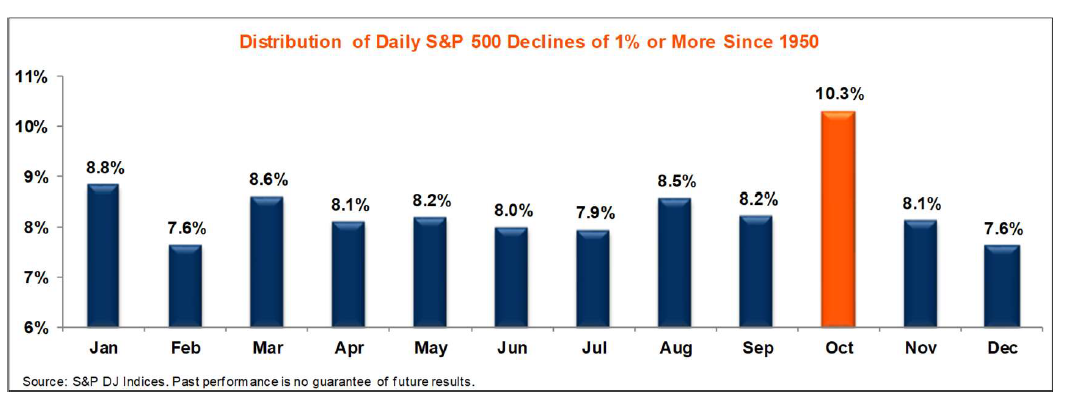Bitcoin price today: dips to $92k as Fed cut doubts spark risk-off mood
- After a rocky September, investors should brace for more violent swings and sharp moves in the weeks ahead.
- October is expected to be another volatile month on Wall Street.
- Key factors to watch include the looming government shutdown, resumption of student loan payments, the start of Q3 earnings season and the possibility of no economic data to chew on.
- Looking for a helping hand in the market? Members of InvestingPro get exclusive ideas and guidance to navigate any climate. Learn More »
Stocks on Wall Street tumbled throughout September as renewed worries over inflation and fresh uncertainty surrounding the future path of the Federal Reserve’s interest rates rattled investors.
Heading into the final trading session of the month, Wall Streets’ three major indexes are on track to record their worst month of 2023.
The tech-heavy Nasdaq Composite is down the most, plunging about 6% during the month, amid surging Treasury yields. Meanwhile, the benchmark S&P 500 and the blue-chip Dow Jones Industrials Average are on pace to close 4.6% and 3% lower, respectively.

As a brutal September comes to an end, investors should prepare themselves for further turmoil in October, which historically is a spooky month for stocks.
Several of the greatest crashes in stock market history have occurred during the month, including ‘Black Tuesday’ and ‘Black Thursday’ in 1929, as well as ‘Black Monday’ in 1987 and the worst of the 2008 financial crisis meltdown.

Source: Hulbert Ratings
In addition, the U.S. stock market historically has experienced extraordinary volatility in October. According to research from LPL Financial, there are more 1%-or-larger swings in October in the S&P 500 than in any other month in history, dating back to 1950. Source: S&P, DJ Indexes
Source: S&P, DJ Indexes
Some have dubbed this market oddity as the ‘October Effect’.
With investors continuing to gauge the outlook for the economy, inflation, and interest rates, a lot will be on the line in the month ahead. Here are the four factors to watch out for:
1. U.S. Government Shutdown Looms
Federal elected officials have only until midnight on Saturday, September 30 to come up with a deal to fund federal agency programs or face the prospect of a government shutdown on Sunday, October 1.
Republican U.S. House Speaker Kevin McCarthy this week rejected a stopgap funding bill advancing in the Senate, bringing Washington closer to its fourth shutdown in a decade.
While some government shutdowns have been brief, the last one in late 2018 to early 2019 lasted five weeks.
President Joe Biden has urged Congress to pass a short-term extension of fiscal 2023 spending, along with emergency aid to help state and local governments deal with natural disasters and assist Ukraine in its war against Russia. He also sought new border security funding.
House Republicans want much tougher legislation that would stop the flow of immigrants at the U.S. southern border with Mexico and deeper spending cuts than were enacted in June.
The standoff comes four months after the U.S. flirted with default, a move that would have rocked financial markets worldwide.
Both Moody's and Fitch warned that further gridlock in Washington could damage the federal government's creditworthiness. Another downgrade of the U.S. credit rating could push borrowing costs even higher.
Fresh uncertainty on the political front may determine how Fed officials weigh the risks facing the U.S. economy and how that will impact their next move on interest rates.
2. Student Loan Repayments Resume
Federal student loan payments, which had been put on hold since the COVID-19 pandemic began in 2020, are set to resume on Sunday, October 1.
That means that after a three-year pause, 44 million Americans will need to start paying back their student loan debts.
With consumers facing the renewal of student loan repayments that will likely divert from other spending, Goldman Sachs economists have warned of a fourth-quarter "pothole" that could knock more than one percentage point off GDP growth.
Indeed, with aggressive Fed interest rate hikes still working their way through the economy, banks tightening credit, and consumers approaching the end of their pandemic-era savings, it may not take much to jolt the economy into recession.
3. U.S. Data to Be Delayed During Shutdown?
The publication of major U.S. economic data, including the closely watched employment and inflation reports, will be suspended indefinitely should the federal government shut down at the end of this week due to lack of funding.
The suspension of the reports would occur across all government agencies such as the Labor Department's Bureau of Labor Statistics (BLS) and the Commerce Department's Census Bureau and Bureau of Economic Analysis (BEA).
As a result, the September jobs report scheduled for Friday, October 6, and the CPI inflation report due on Thursday, October 12 would not be released unless Congress manages to pass a funding bill that President Joe Biden would sign into law.
A government shutdown would also result in delays in other key data, including retail sales, housing starts, and new home sales. Depending on the duration of the shutdown, the release of the first estimate of third-quarter GDP due in late October could also be impacted.
Weekly jobless claims data will also not be published during a shutdown, leaving both Fed officials and investors in the dark.
A data blackout would come at a critical time for the Fed, which held rates steady at its policy meeting earlier this month and made clear that the remaining two meetings of the year will be data-dependent.
In that sense, a government shutdown might make the Fed more cautious in raising rates. It could, at least, push any potential hike back to December when the Fed has a clearer economic picture once any disruption to data releases presumably would be resolved.
Currently, the markets estimate the Fed is becoming less likely to move rates up in November. The increasing chance of shutdown might, in part, be why.
4. Q3 Earnings Season Kicks Off
A flood of earnings from some of the biggest names in the market will await investors in October as Wall Street’s third-quarter reporting season kicks off.
The Q3 earnings season unofficially begins on Friday, October 13, when notable companies like JPMorgan Chase (NYSE:JPM), Citigroup (NYSE:C), Wells Fargo (NYSE:WFC), and UnitedHealth (NYSE:UNH) all report their latest financial results.
The following week sees high-profile names like Netflix (NASDAQ:NFLX), Bank of America (NYSE:BAC), Goldman Sachs (NYSE:GS), Morgan Stanley (NYSE:MS), American Express (NYSE:AXP), AT&T (NYSE:T), Johnson & Johnson (NYSE:JNJ), and United Airlines (NASDAQ:UAL) report earnings.
Earnings will gather pace in the final week of the month when the mega-cap tech stocks report their latest quarterly results. Microsoft (NASDAQ:MSFT) and Google-parent Alphabet (NASDAQ:GOOGL) report on Tuesday, October 24, followed by Facebook-owner Meta Platforms (NASDAQ:META) on Wednesday, October 25.
Investors are bracing for what may be another rocky reporting season amid the negative impact of several macroeconomic headwinds.
After earnings per share for the S&P 500 fell -4.1% in the second quarter of 2023, earnings are expected to drop -0.2% in the third quarter when compared to the same period last year, as per data from FactSet. If that is confirmed, it would mark the fourth straight quarter of earnings declines reported by the index.
Revenue expectations for Q3 2023 are slightly more promising, with sales growth expected to increase +1.5% from the same quarter a year earlier. However, that is well below the five-year average revenue growth rate of +7.7%.
Beyond the top-and-bottom-line numbers, investors will pay close attention to announcements on forward guidance for the rest of the year and early 2024, given the uncertain macroeconomic outlook.
Between fears over a looming government shutdown, mounting recession worries, uncertainty over the Fed’s rate plans, and slowing earnings growth, the Dow, S&P 500, and Nasdaq look set to remain under pressure in October.
***
Disclosure: At the time of writing, I am short on the S&P 500, Nasdaq 100, and Russell 2000 via the ProShares Short S&P 500 ETF (SH), ProShares Short QQQ ETF (PSQ), and ProShares Short Russell 2000 ETF (RWM). Additionally, I have a long position on the Energy Select Sector SPDR ETF (NYSE:XLE) and the Health Care Select Sector SPDR ETF (NYSE:XLV).
I regularly rebalance my portfolio of individual stocks and ETFs based on ongoing risk assessment of both the macroeconomic environment and companies' financials.
The views discussed in this article are solely the opinion of the author and should not be taken as investment advice.

